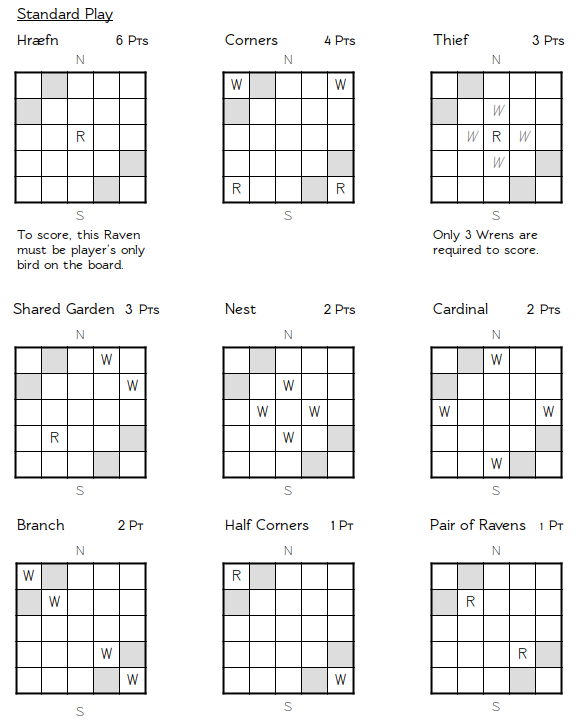Up until Wrenna 1.1 I had simply thrown points and Plays together with minimal thought:
Therefore: Plays with more pieces pay out more points.
I knew it wasn't sound logic, but it was sound enough to get the game rolling. I didn't want to waste months fussing around theorising the mathematics of pieces moving this way and that on a 5x5 grid. My brain is not that mathematical.
Truth be told, I don't expect to win even half the games after my testers become experienced. This has so far proven true.
But I digress…
The time had come to adjust scoring. Not being a maths fiend, nor even approaching a chess apprentice, I was dreading this more than little.
I ended up with the following scoring:

The revamped Plays
This, I'm sure, will be far from the first iteration of this playsheet.
With this revision I hoped to move the action away from the centre of the board. I worked with two premises which cascade in importance:
- (More important) The further most birds are from gates, the more points scored
- (Less important) The less birds required, the less points scored
- With the caveat that "Hræfn" requires all other pieces to be off the board (and so is harder to score and so is worth the most points)
In doing this, I have managed to avoid doing the real work of looking at true relationships between each play. Either I'm going to have to learn matrices and deep dive into game theory (or whatever other maths is required), or I'll have to befriend someone who can help out. Either way, this is at least the start of the start of the playsheet iterations. It's getting the ball rolling.
The (Latest) Rules of Wrenna (2.0)
Set Up
- Place the board in the centre of playing area. There are 4 gates on a board. Gates are located in the North West and South East corners. Players sit north and south of these
- The most experienced player always plays as North and sits on the northern edge of the board, with South sitting opposite.
- If both players are of equal experience, North is decided through random selection (coin toss, dice, drawn straws, &c.)
- Playing pieces are separated into colours. Players must each have 2 larger pieces used as Ravens, and 4 smaller pieces used as Wrens
- Prepare a method of recording scores
- South player always plays first
Objective
The objective of Wrenna is to be the first player to score 10 points.
Gameplay
Wrenna is played in 2 phases:
Phases
Flock (Phase 1)
Players take turns to place one bird on the board each turn. This may be any combination of Ravens and Wrens. Players must place birds and cannot pass. Flock ends when both players each have 4 birds on the board.
When playing in Flock Ravens may only be placed in the outermost squares.
Hop (Phase 2)
Players take turns to move 1 of their own birds exactly 1 square (orthogonal and diagonal movement is permitted). Players must make a move on their turn. There may only be 1 bird in each square, however there are no other limits to which square a bird may move.
Players may also move birds off or onto the board. See flying (below). Players may have a maximum of 4 birds each on the board at one time.
Flying
Players each have 6 birds, but are only permitted a maximum of 4 each on the board at any one time. It is possible to move birds on and off the board by Flying them.
A bird may only be moved off or onto the board through a Gate.
To Fly birds:
- Move bird onto Gate (1 turn).
- Move bird off the board (1 turn).
- (Optional) Move new bird onto the board at any Gate (1 turn).
Scoring & End of Game
Players score points by moving their own birds into arrangements — or Plays — found on the playsheet. When a player forms a Play with their own birds they announce which Play they have formed and record the associated points.
A player cannot form the same Play twice in a row.
When a player has scored at least 10 points they are declared the winner and the game ends.
I think I still have a few things to work out before blind PnP Playtests on BGG. But I think the game is getting into that territory. There isn't much chance for in-person testing right now — that's a certainty.
You may have noted the title "Standard Play" on top of the Playsheet. I have other Plays in mind (or, rather, in spreadsheet) that I will detail in the next entry. I'm calling those, for now, Extended Plays.


